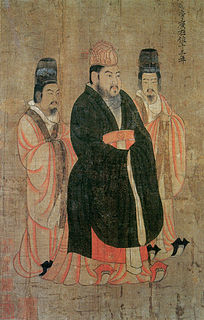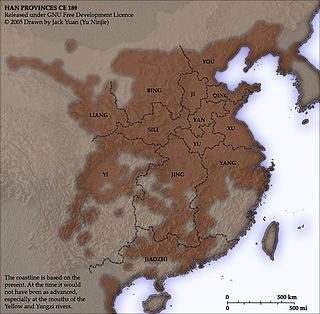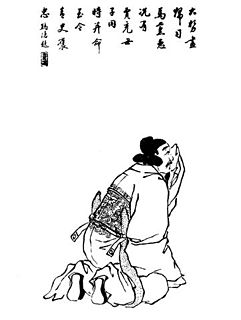The history of the administrative divisions of the Imperial China is quite complex. Across history, what is called 'China' has taken many shapes, and many political organizations. For various reasons, both the borders and names of political divisions have changed—sometimes to follow topography, sometimes to weaken former states by dividing them, and sometimes to realize a philosophical or historical ideal. For recent times, the number of recorded tiny changes is quite large; by contrast, the lack of clear, trustworthy data for ancient times forces historians and geographers to draw approximate borders for respective divisions. But thanks to imperial records and geographic descriptions, political divisions may often be redrawn with some precision. Natural changes, such as changes in a river's course, or loss of data, still make this issue difficult for ancient times.

Emperor Yang of Sui, personal name Yang Guang (楊廣), alternative name Ying (英), Xianbei name Amo (阿摩), also known as Emperor Ming (明帝) during the brief reign of his grandson Yang Tong), was the second son of Emperor Wen of Sui, and the second emperor of China's Sui dynasty.
Yan Xiang, courtesy name Wenze, was an official who lived during the late Eastern Han dynasty of China. A similarly named Yan Xiang (閻象) also served under the warlord Yuan Shu as a registrar. Although it is not clear whether they were the same person, the historian Rafe de Crespigny mentioned that it could be assumed that Yan Xiang left Yuan Shu and defected to the Han central government, which was then under the leadership of the warlord Cao Cao.
Qian Hong was an official of the Jin dynasty of China. He previously served in the state of Cao Wei during the Three Kingdoms period. His father, Qian Zhao (牽招), was a notable military general of the Cao Wei state.

You Prefecture or Province, also known by its Chinese name Youzhou, was a prefecture (zhou) in northern China during its imperial era.
Yuzhou or Yu Province was one of the Nine Provinces of ancient China, later to become an administrative division around the reign of Emperor Wu of the Western Han dynasty.

The Sixteen Kingdoms, less commonly the Sixteen States, was a chaotic period in Chinese history from 304 to 439 CE when the political order of northern China fractured into a series of short-lived dynastic states, most of which were founded by the "Five Barbarians," non-Chinese peoples who had settled in northern and western China during the preceding centuries and participated in the overthrow of the Western Jin dynasty in the early 4th century. The kingdoms founded by ethnic Xiongnu, Xianbei, Di, Jie, Qiang, as well as Chinese and other ethnicities, took on Chinese dynastic names, and fought against each other and the Eastern Jin dynasty, which succeeded the Western Jin and ruled southern China. The period ended with the unification of northern China in the early 5th century by the Northern Wei, a dynasty established by the Xianbei Tuoba clan, and the history of ancient China entered the Northern and Southern dynasties period.
Sima Fang (149–219), courtesy name Jiangong or Wenyu, was an official who lived during the Eastern Han dynasty of China. Through his second son Sima Yi, he was an ancestor of the ruling Sima clan of the Jin dynasty (265–420) of China.
Jingzhou or Jing Province was one of the Nine Provinces of ancient China referenced in Chinese historical texts such as the Tribute of Yu, Erya and Rites of Zhou.

Wang Jing, courtesy name Yanwei, was an official of the state of Cao Wei during the Three Kingdoms period of China.
Yangzhou, Yangchow or Yang Province was one of the Nine Provinces of ancient China mentioned in historical texts such as the Tribute of Yu, Erya and Rites of Zhou.
Jingzhao was a historical region centered on the ancient Chinese capital of Chang'an.
Wei Kang, courtesy name Yuanjiang, was an official who lived in the late Eastern Han dynasty of China.
Henan Commandery was a commandery in China from Han dynasty to Tang dynasty, located in modern northern Henan province.
Fufeng, also known as You Fufeng, was a historical region located in modern western Shaanxi.
Pingyi, also known as Zuo Pingyi, was a historical region of China located in modern Shaanxi province.
Wei Commandery was a historical commandery of China, located in modern southern Hebei and northern Henan.
Suo Lin, or Suo Chen, courtesy name Juxiu, was a military general of the Jin Dynasty (266-420). He was a prominent member of the group at Anding to restore the Jin Dynasty authority in the north following the Disaster of Yongjia in 311, and in the regime's final years, he was Emperor Min's most influential advisor along with Qu Yun. As Emperor Min's rule came to a close in 316 as Han Zhao forces besieged the capital Chang'an, Suo Lin took advantage of the emperor's surrender to ensure a high position in Han's government by secretly sending his son to negotiate. However, Han's commander, Liu Yao denied his proposal and beheaded his son. After the emperor surrendered, Suo Lin was executed in Pingyang for his disloyalty.
The Du clan of Jingzhao (Chinese: 京兆杜氏; Wade–Giles: Jing1 Zhao4 Du4 Shi4) was a prominent Chinese clan, centred around the Jingzhao region (modern day Xi'an). Tracing its origins back to the Western Han Dynasty, it retained its prominence in Chinese politics and society up to the end of the Tang Dynasty.
Yan Ding, courtesy name Taichen, was a military general of the Jin dynasty (266–420). At the time of the Disaster of Yongjia in 311, Yan Ding brought the nephew of Emperor Huai, Sima Ye, to Chang'an, where a group of loyalists from Anding were in the process of retaking the region from Han Zhao forces. After the re-establishment of the Jin government, Yan Ding became a powerful member of the new regime but jealousy and suspicion would cut his career short as his peers Qu Yun and Suo Lin combined their forces to have him killed.




